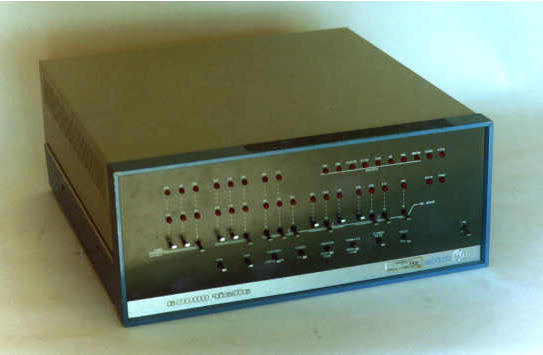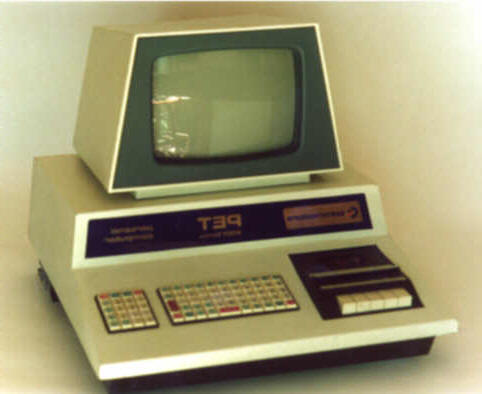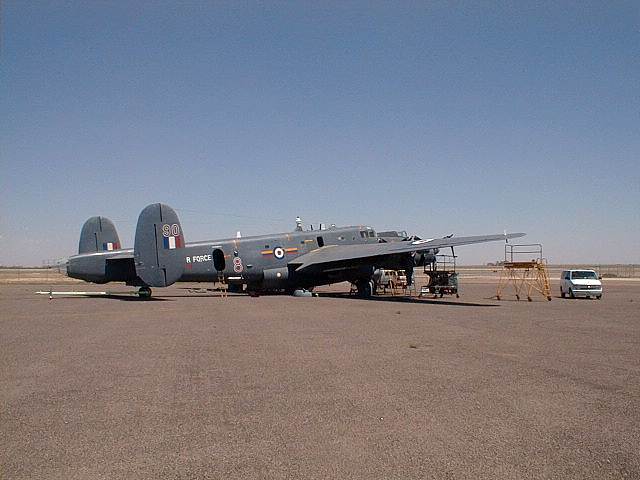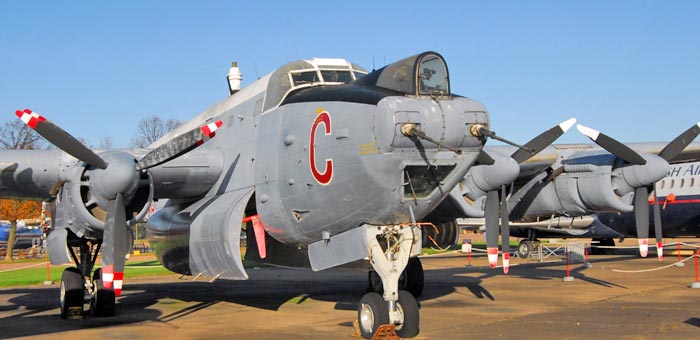|
|
||
|
|
Radschool Newsletter |
Vol 7 Page 4 |
|
|
||
|
Computers and Stuff
Sam Houliston. |
||
|
|
||
|
The first Personal Computer.
It seems that the personal computer that everyone takes for granted has been around for ever, but it is really only a very recent invention.
The Altair 8800 is generally accepted as the first "Personal Computer". It was designed by a bloke named Ed Roberts from a company called MITS, and was introduced in April 1974 at one of the amateur computer clubs that were formed in what is now known as Silicon Valley. It was a "build it yourself" unit with chassis, power supply, system PCB, and loaded with 256 bytes of memory. There were no I/O devices, it didn't have a monitor or a keyboard and there was no Operating System available, and you programmed the system from the front panel (octal) switches (see photo above). The Altair 8800 made its debut in an article that appeared on the cover of the December 1975 issue of Popular Electronics. Within two months the little company MITS, was struggling with thousands of orders. The computer came in kit form and required quite a bit of work and skill to assemble. Users would enter their programs in binary by flipping switches on the front panel of the machine. The output could be read in binary on the LEDs. No software was available for the little machine and users would have to write their own.
The basic unit had only 256 bytes of RAM and cost $395. This configuration made the little machine virtually useless for any real problem solving. However it was designed to be expandable with a bus that allowed plug in cards. The bus was to set the standard for the next 5 years. Within months expansion boards were available to add more memory and attach terminals or teleprinters.
One of the most popular peripherals was the Teletype corporation’s ASR-33 teletype. This provided a printer, keyboard, and storage device (paper tape). This first desktop computer spawned the idea that computers could be built small and developed without the resources of IBM, Univac, Burroughs and the other mega powers of the computer business at that time.
The first IBM "clone" PC.
The first true IBM bus compatible "clone" personal computer was the MPC introduced by Columbia Data Systems in June of 1982. There had been several MS-DOS compatible personals up to that time that ran DOS programs but they had proprietary busses or designs that limited their broad acceptance.
Columbia shipped the first hard drive based systems (5MB formatted capacity) before IBM did. Their controller was not compatible with the controller that IBM shipped later and Columbia quickly responded with a (mostly) IBM compatible replacement.
Firsts.
The first electronic spreadsheet written for the personal computer was VisiCalc. The first popular word processor for micro-computers was Electric Pencil. It was available in December 1976. The first integrated circuit was produced by Texas Instruments in Sep 1958. Prior to this development in electronic circuits consisted of resistors, capacitors, transistors and wiring/etches.
Each component was manufactured separately by different processes and integrated into an electronic circuit on a PCB using wiring/etches and solder connections to create a working circuit. Jack Kilby came up with the idea of creating an "integrated circuit" using a silicon wafer. By adding impurities to the silicon they could create resistance, capacitance, transistor junctions and conductive paths on a single silicon "chip". This IC would be a self contained circuit with no external wiring or solder connections.
The first handheld calculator using IC's was produced by Texas Instruments in 1967. It performed the 4 basic functions of the calculators of those days add, sub, mul, div.
While working for IBM in the late 1960's, Alan Shugart is generally regarded as the inventor of the floppy drive He later founded Shugart Associates to design and manufacture floppy drives. (This info was pinched from the web)
|
||
|
Excel 97.
If you use Microsoft’s Excel 97, you might want to try this little experiment. (Only works with ‘97)
|
||
|
THE SHACKLETON.
This magnificent aircraft, which looked like an antique even when it was brand new, was the Pommy’s maritime search aircraft The Shackleton. Fondly known (by the Pomms) as 10,000 loose rivets flying in close formation, they used to call into RAAF bases on a fairly regular basis in the late 60’s, early 70’s.
Shortly after WW2, the Pomms were looking for a maritime patrol aircraft that had long range, the ability to carry a bunch of sensors and weapons, and could offer a hint of crew comfort. They came up with an aircraft that comprised a large, lightly-loaded wing attached to a strong, load-bearing centre section, a damn big fuselage and bomb bay and four big beefy engines to get it all going. Airborne, it was a noisy aeroplane that shook like a drunk with the DTs, and its engines were temperamental and leaked oil like an Arabian oilfield. It was uncomfortable, you froze in the front end and cooked in the back, and moving from one end to the other was like an army assault course. But those that flew in it, and those who worked on it—loved it. Strange bunch the Pomms.
The engines were Griffins which were updates of the brilliant Merlin engine that was so vital to the RAF during WW11, and the contra-rotating prop gave it a distinctive “growl”. The name Shackleton was chosen in honour of Sir Ernest Shackleton, one of Britain's greatest voyagers and explorers.
First delivered in April 1951, they say it was easy to fly with no real vices (as long as you didn't take liberties), but from the beginning there were some shortcomings apparent in the MkI design. The chin mounted radome was prone to birdstrike damage and its position prevented the desired 3600 radar scan. The single tail wheel was too weak to cope with the weight of the aircraft in anything more than reasonable loads and the pneumatic braking system was rather inefficient and made ground handling difficult. Accordingly, in the MkII the radar was moved back to a vertical position, behind the wing and in a retractable radome, and hydraulic brakes were fitted. The nose was also lengthened and given a bomb aimer's position and a nose gunner's position was equipped with twin 20 mm cannons.
The MK111 was bigger again, the tail wheel was moved to the front, it had a modified wing with tip tanks, carried extra fuel, had full sound insulation, a proper galley and rest area and a tasteful creamy-brown interior. This bigger fuselage was crammed with as much stuff as could be fitted, with the result that, in the case of the MkIII - Phase3, the all-up weight rose to 108,000 lbs. compared with the 82,000 lbs of the MkIA. Even the mighty Griffons couldn’t be relied upon to get that lot off the common-place 6,000 ft. runways, so a pair of Avgas-burning Viper jets, similar to a Neppy, were installed in the outboard engine nacelles to assist with the task. It was proposed to re-engine the Shacks with the revolutionary Napier compound diesel-turbine engine that had recently been developed, and which positively sipped fuel in comparison with the Griffon. This engine would have enabled the Shack to stay airborne even longer but the idea didn’t take off. To crews already carrying out 18 hour sorties this idea didn't exactly seem like manna from heaven.
The Shackleton in various marks and phases has served in just about every corner of the world and in just about every role that aircraft undertake except that of pure fighter, and they flew largely unsupported. They were prone to engine problems as the Griffon engine, for all its brute strength, was a remarkably sensitive piece of equipment that went into a deep sulk at the drop of a hat. It had one particularly infuriating habit - that of jamming up its starter motor. The “quick fix” was to whip a panel off and give the starter a savage belt with a large spanner.
One of the major duties of the Shackleton was search and rescue. She is still reckoned by many to be the best land-based fixed-wing SAR platform ever built. With her slow speed, long range, multiplicity of excellent lookout positions and ability to carry large amounts of SAR equipment, she was brilliant in the role. The Shackleton's success in this demanding role was such that even in her twilight days in the anti-sub warfare game she could still surprise the supposedly superior Orions and Nimrods.
For over 20 years the Shack was the UK's only long range Maritime Patrol Aircraft, responsible for the detection and tracking of all potentially hostile shipping both on and under the sea, and she excelled. In the early 60’s, the demise of the Royal Navy's carriers left the Pomms without any AEW cover, and it was decided that the RAF needed a modern long-range aircraft to provide coverage for the UK air defence. Such an aircraft would not be available until 1976 at the earliest (the modified Comet 4), so a short-term "interim solution" was to fit the APS-20 radar from the now surplus Royal Navy Gannets to the Shacks (blokes who worked on the Neppys will know this bit of gear).
She was finally put out to pasture in 1981. |
||
|
|
||
|
Counter sine Mar 2017 |
||
|
|
||
|
|
||



